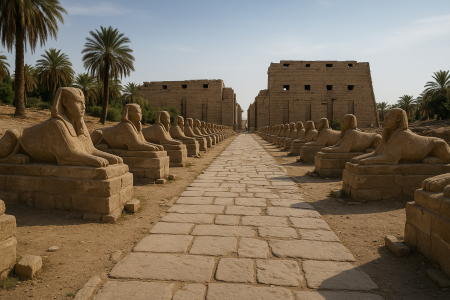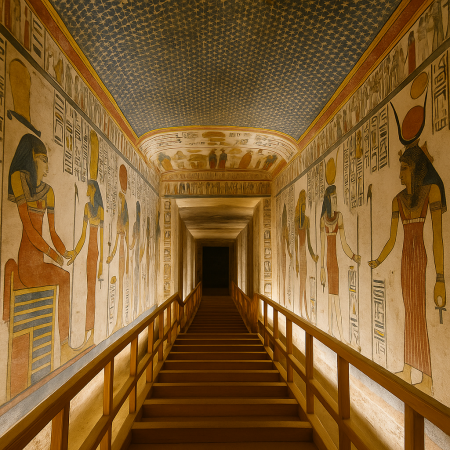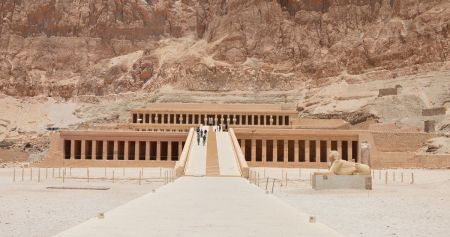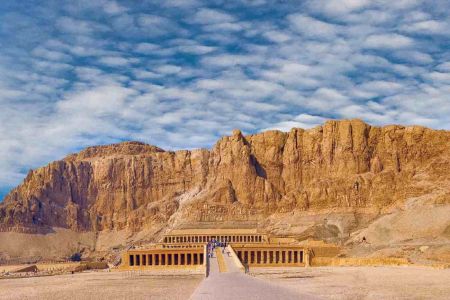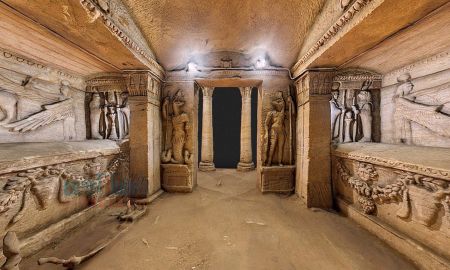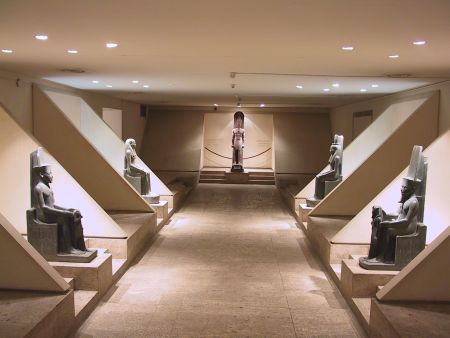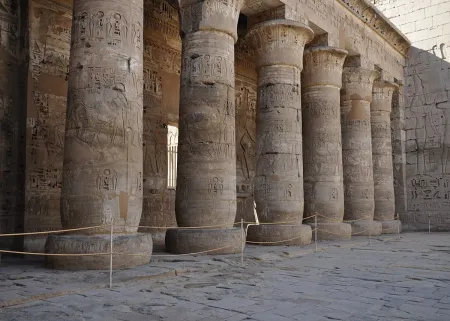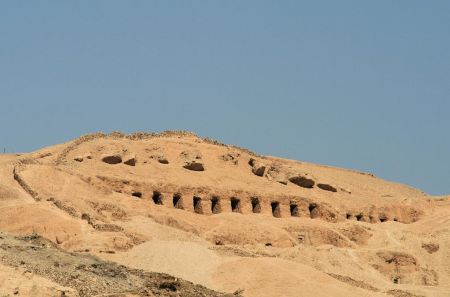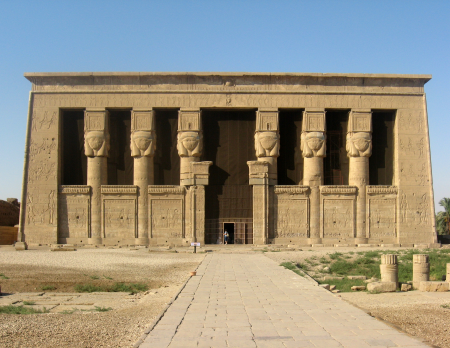Karnak Temple: The Ancient Wonder of Luxor
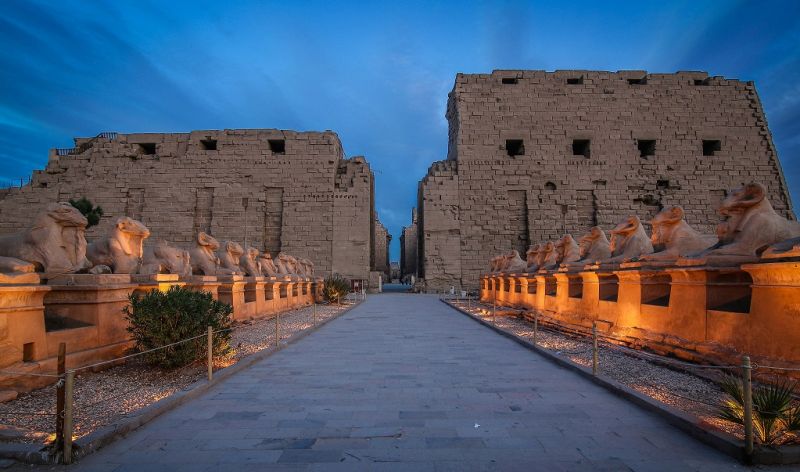
Located on the east bank of the Nile in the heart of Luxor, Karnak Temple stands as a colossal open-air museum, revealing centuries of religious devotion, political power, and architectural mastery. Spanning over 200 acres, it’s not just a single temple but a vast complex of sanctuaries, pylons, chapels, and obelisks that evolved over 2,000 years. Karnak was the spiritual epicenter of ancient Thebes and the largest religious complex ever built in ancient Egypt. Dedicated mainly to the Theban triad—Amun, Mut, and Khonsu—Karnak became the center of worship and one of the most visited archaeological sites in the world.
More than just ruins, Karnak Temple is a living chronicle of pharaonic ambition. It saw contributions from nearly every pharaoh of the New Kingdom and beyond, including Hatshepsut, Seti I, Ramses II, and even the Ptolemies. Today, the site is a must-see for travelers to Egypt, drawing both archaeologists and awe-struck visitors with its sheer scale, architectural genius, and spiritual atmosphere.
The Great Hypostyle Hall: A Forest of Stone
An Architectural Feat Beyond Its Time
The Great Hypostyle Hall within the Karnak Temple complex is one of the most iconic features of ancient Egyptian architecture. Spanning an area of 54,000 square feet, the hall boasts 134 massive sandstone columns, some soaring to 21 meters high. These papyrus-shaped columns are arranged in 16 rows and were once covered in vibrant colors and detailed inscriptions. Walking through this stone forest gives visitors a sense of grandeur that few ancient structures can match.
Political and Religious Symbolism
Built primarily during the reigns of Seti I and Ramses II, the hall was more than just an architectural marvel—it was a political statement. The towering columns and detailed reliefs emphasized the pharaoh’s divine authority and eternal connection to the gods. The inscriptions and imagery reflect not only rituals and offerings but also scenes of military triumph and royal lineage, projecting the king’s power both in life and the afterlife.
Sacred Lake and the Temple Precincts
The Ritual Significance of Water
The Sacred Lake of Karnak, situated within the precinct of Amun, played a vital role in temple rituals. This man-made body of water was used by priests for ceremonial purification and by temple workers for daily activities. Reflecting the heavens, the lake symbolized the primeval waters from which all life emerged in Egyptian cosmology.
Temple of Ptah, Temple of Khonsu, and the Opet Festival
The Karnak complex isn’t limited to the main temple of Amun. Within its massive walls lie other remarkable structures like the Temple of Ptah and the Temple of Khonsu, each representing various aspects of Theban theology. One of the most significant festivals celebrated here was the Opet Festival, during which the statue of Amun was paraded from Karnak to Luxor Temple, reinforcing the divine power of the pharaoh and the sanctity of Amun.
Avenue of Sphinxes and the Connection to Luxor Temple
A Processional Path Like No Other
One of Karnak’s most striking modern discoveries is the Avenue of Sphinxes—a 2.7-kilometer-long processional road lined with hundreds of sphinx statues connecting Karnak to Luxor Temple. Recently restored and opened to the public, this path once served as the ceremonial route for religious processions, particularly during the Opet Festival. Walking along the avenue offers visitors a glimpse into the religious grandeur of ancient Thebes.
Experience elegance on board the Best Nile River Cruises
Karnak Temple Today: Restoration, Tourism, and Legacy
Preserving the Past for Future Generations
Ongoing restoration efforts by the Egyptian Ministry of Tourism and Antiquities, in collaboration with international teams, have made Karnak more accessible and informative. Improved signage, lighting, and guided tours allow visitors to fully appreciate the temple’s scale and significance.
A Pillar of Egyptian Tourism
Karnak Temple remains one of the top attractions in Egypt, drawing millions of visitors each year. Its inclusion in Luxor’s open-air museum tour, alongside the Valley of the Kings and Luxor Temple, makes it a cornerstone of Upper Egypt’s tourism economy.
Symbolism and Spiritual Meaning
The Home of the God Amun-Ra
The Temple of Karnak was considered the earthly home of Amun-Ra, the king of the gods. As such, its design reflected not only royal ambition but divine architecture. Every chamber, corridor, and column served a spiritual function, echoing the ancient belief in Ma’at (cosmic order).
Astronomical Alignments and Sacred Geometry
Archaeologists have noted that several parts of the Karnak complex align with celestial events, especially the solstices and equinoxes. This hints at the Egyptians’ deep understanding of astronomy and their incorporation of sacred geometry in temple design, enhancing the spiritual potency of the site.
Planning Your Visit to Karnak Temple
Best Time to Visit Karnak
The ideal time to explore Karnak is from October to April when Luxor enjoys cooler temperatures. Early mornings offer the best light for photography and fewer crowds, giving visitors a more immersive experience.
Tickets, Access, and Amenities
The temple is open daily, and ticket prices are affordable for both locals and international tourists. Guided tours in multiple languages are available at the entrance, and the site includes rest areas, restrooms, and cafes.
Conclusion: The Enduring Majesty of Karnak Temple
Karnak Temple is more than a tourist attraction—it’s a journey through the soul of ancient Egypt. With every column, inscription, and sunbeam that filters through its ruins, it whispers the story of a civilization that revered the divine, mastered the monumental, and etched its legacy into stone. Whether you’re a history lover, a spiritual seeker, or an architecture enthusiast, Karnak promises an unforgettable experience at the heart of human heritage.
FAQs About Karnak Temple
What is Karnak Temple famous for?
Karnak Temple is renowned for being the largest religious structure ever built in ancient Egypt, featuring the iconic Hypostyle Hall, colossal statues, obelisks, and centuries of inscriptions.
Is Karnak Temple the same as Luxor Temple?
No, they are separate temples. Karnak is larger and older, while Luxor Temple lies to the south. They are connected by the Avenue of Sphinxes and were used together during religious festivals.
Who built Karnak Temple?
Karnak saw contributions from over 30 pharaohs, including Thutmose III, Ramses II, and Hatshepsut. Construction spanned from the Middle Kingdom to the Greco-Roman period.
Can I visit Karnak Temple at night?
Yes, Karnak Temple offers a spectacular Sound and Light Show in the evening that narrates the history of the site with dramatic lighting and storytelling.
How long should I spend at Karnak Temple?
A thorough visit can take between 2 to 3 hours. To fully appreciate the temple, especially with a guide, plan for at least half a day.


